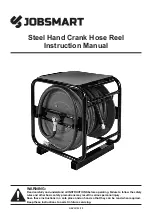
© Panduit Corp. 2018
OPERATION INSTRUCTIONS
CT-460
CT-460: PA24481A01_04
Page: 3 of 4
6-2018
IN-SERVICE TOOLS – AFTER TOOLS HAVE BEEN IN SERVICE
1. CLEAN AND VISUALLY
INSPECT FOR DAMAGE
ONCE A MONTH.
In-service tools should be cleaned and inspected at least ONCE A MONTH. To
clean---immerse in a commercial degreasing compound and wipe clean with a
lint free cloth. If a degreasing compound is not available, wipe with a clean cloth.
2. CHECK DIE CLOSURE
After cleaning, inspect the crimping dies for proper die closure. See FIG. 6
for plug gaging instructions.
3. LUBRICATE TOOL ONCE
A WEEK.
4. CLEAN EXCESS OIL
FROM CRIMP DIES AND
USE.
In-service tools should be lubricated ONCE A WEEK, and after every cleaning.
Lubricate all pins, pivots and bearing surfaces with a good grade S.A.E. 20 or
equivalent motor oil. Be sure to clean any excess oil from crimping dies before
using.
VISUAL INSPECTION
1.
Visually inspect tool for missing or loose pins; then close the tool and note the return action of the handles.
2.
Remove the terminal locator and visually inspect the crimping dies for worn, chipped or broken surfaces.
Damaged crimping dies are objectionable and may go undetected when gaging the die closure.
3.
If parts are missing, defective or damaged; contact your local Panduit Sales Office for information on repair or
replacement of tools; or contact Technical Support at 1-800-777-3300.
DIE CLOSURE INSPECTION: CT-460
Die Closure inspection is made by using the GO/NO-GO gaging dimensions listed in
TO PERFORM DIE CLOSURE INSPECTION
1.
Clean die and plug gage surfaces.
2.
Close tool handles until crimping jaws are bottomed and handles are fully closed.
3.
Using the proper gage member, insert the GO side into the die – it must pass completely through the
closure.
4.
Reverse the gage and try to insert the NO-GO side into the die closure (Do Not use excessive force). The
NO-GO side may partially enter the die closure but must not pass completely through.
5.
Perform the above procedure for both the crimp die closure and the insulation die closure, as listed in FIG. 6






















